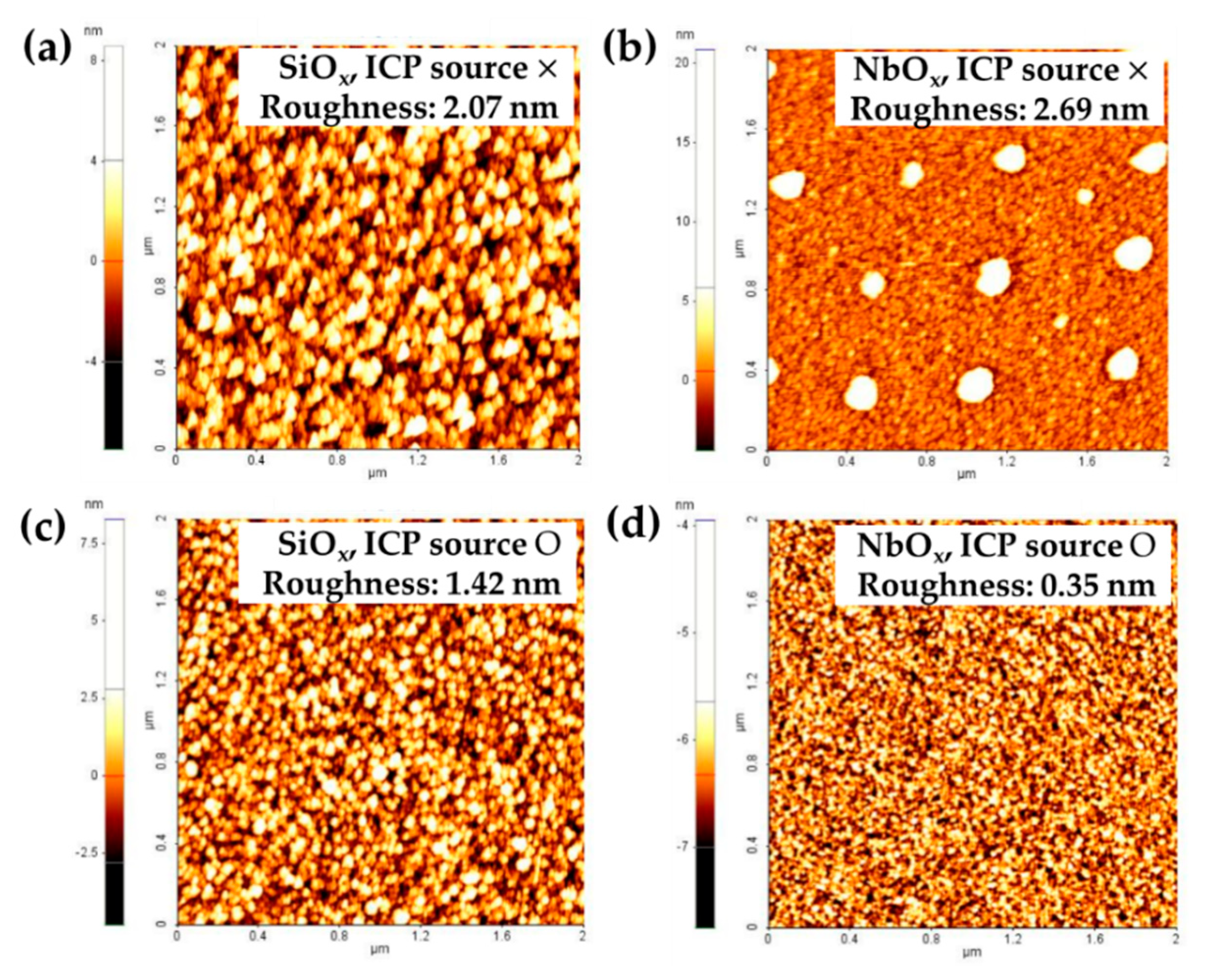Multi-Layer Anti-Reflection Film Based on SiOx and NbOx by DC Pulse Sputter System with Inductively Coupled Plasma Source
Abstract
1. Introduction
2. Materials and Methods
2.1. Materials
2.2. Characteristics
2.3. Fabrication of High-Quality Multi-Layers AR Film Based on SiOx and NbOx (M-SiNb)
3. Results
3.1. Characteristics of SiOx and NbOx Single Layer
3.2. Characteristics of the Multi-Layer AR Film Based on SiOx and NbOx (M-SiNb)
4. Conclusions
Author Contributions
Funding
Acknowledgments
Conflicts of Interest
References
- Kim, M.; Kang, T.W.; Kim, S.H.; Jang, E.H.; Park, H.H.; Seo, J.; Lee, S.J. Antireflective, self-cleaning and protective film by continuous sputtering of a plasma polymer on inorganic multilayer for perovskite solar cells application. Sol. Energy Mater. Sol. Cells 2019, 191, 55–61. [Google Scholar] [CrossRef]
- Castellón, E.; Zayat, M.; Levy, D. Sol-gel materials for electro-optical and optically active humidity-sensitive devices. J. Solgel Sci. Technol. 2019, 89, 56–61. [Google Scholar] [CrossRef]
- Ying, S.P.; Fu, H.K.; Hsieh, H.H.; Wu, J.H. Optical film design of low-glare LED panel light. Opt. Laser Technol. 2019, 111, 45–50. [Google Scholar] [CrossRef]
- Kim, J.; Song, S.; Kim, Y. A Basic Study on Anti-reflection Coating PV Technology for Reducing Reflected Sunlight on the Building Skin. Asia-pacific Journal of Convergent Research Interchange 2019, 5, 23–30. [Google Scholar] [CrossRef]
- Macleod, H.A. Thin-film Optical Filters, 5th ed.; CRC Press: Boca Raton, FL, USA, 2017; pp. 1–251. [Google Scholar]
- Kim, J.Y.; Han, Y.K.; Kim, E.R.; Suh, K.S. Two-layer hybrid anti-reflection film prepared on the plastic substrates. Curr. Appl. Phys. 2002, 2, 123–127. [Google Scholar] [CrossRef]
- Lee, J.H.; Jang, G.E.; Jun, Y.H. Investigation and evaluation of structural color of TiO2 coating on stainless steel. Ceram. Int. 2012, 38, S661–S664. [Google Scholar] [CrossRef]
- Jeong, S.H.; Kim, J.K.; Kim, B.S.; Shim, S.H.; Lee, B.T. Characterization of SiO2 and TiO2 films prepared using rf magnetron sputtering and their application to anti-reflection coating. Vacuum 2004, 76, 507–515. [Google Scholar] [CrossRef]
- Hassanien, A.S.; Akl, A.A. Optical characterizations and refractive index dispersion parameters of annealed TiO2 thin films synthesized by RF-sputtering technique at different flow rates of the reactive oxygen gas. Physica B Condens. Matter 2020, 576, 411718. [Google Scholar] [CrossRef]
- Coskun, Ö.D.; Demirela, S. The optical and structural properties of amorphous Nb2O5 thin films prepared by RF magnetron sputtering. Appl. Surf. Sci. 2013, 277, 35–39. [Google Scholar] [CrossRef]
- Xi, J.Q.; Kim, J.K.; Schubert, E.F.; Ye, D.; Lu, T.M.; Lin, S.Y.; Juneja, J.S. Very low-refractive-index optical thin films consisting of an array of SiO2 nanorods. Opt. lett. 2006, 31, 601–603. [Google Scholar] [CrossRef]
- Depla, D.; Mahieu, S. Reactive Sputter Deposition; Springer: Berlin, Germany, 2008; pp. 1–254. [Google Scholar]
- Wu, W.Y.; Chan, M.Y.; Chen, G.Z.; Liao, S.C.; Lee, C.H.; Lui, P.W. Structural properties of TiN thin films prepared by RF reactive magnetron sputtering. Surf. Coat. Technol. 2019, 362, 167–175. [Google Scholar] [CrossRef]
- Kwak, B.S.; Boyd, E.P.; Erbil, A. Metalorganic chemical vapor deposition of PbTiO3 thin films. Appl. phys. lett. 1988, 53, 1702–1704. [Google Scholar] [CrossRef]
- Ellmer, K.; Cebulla, R.; Wendt, R. Transparent and conducting ZnO (: Al) films deposited by simultaneous RF-and DC-excitation of a magnetron. Thin Solid Films 1998, 317, 413–416. [Google Scholar] [CrossRef]
- Meziani, T.; Colpo, P.; Rossi, F. Design of a magnetic-pole enhanced inductively coupled plasma source. Plasma Sources Sci. Technol. 2001, 10, 276–283. [Google Scholar] [CrossRef]
- Jiang, X.Z.; Li, W.L.; Wumaier, T.; Yao, H.B. Diagnostic study of argon and oxygen mixtures in dual-frequency capacitively coupled plasmas using quadrupole mass spectrometer. Chem. Phys. Lett. 2019, 730, 472–477. [Google Scholar] [CrossRef]
- Samukawa, S.; Sakamoto, K.; Ichiki, K. Generating high-efficiency neutral beams by using negative ions in an inductively coupled plasma source. J. Vac. Sci. Technol. A 2002, 20, 1566–1573. [Google Scholar] [CrossRef]
- Ashida, S.; Shim, M.R.; Lieberman, M.A. Measurements of pulsed-power modulated argon plasmas in an inductively coupled plasma source. J. Vac. Sci. Technol. A 1996, 14, 391–397. [Google Scholar] [CrossRef]
- Sukhinin, G.I.; Isupov, M.V.; Fedoseev, A.V.; Yudin, I.B. Development of a distributed ferromagnetic enhanced inductively coupled plasma source for plasma processing. J. Phys. Conf. Ser. 2019, 1243, 012004. [Google Scholar] [CrossRef]
- Vlassak, J.J.; Nix, W.D. A new bulge test technique for the determination of Young’s modulus and Poisson’s ratio of thin films. J. Mater. Res. 1992, 7, 3242–3249. [Google Scholar] [CrossRef]
- Cho, Y.; Parmar, N.S.; Nahm, S.; Choi, J.W. Essential Macleod Program (EMP) simulated fabrication of high quality Zn: SnO2/Ag/Zn: SnO2 multilayer transparent conducting electrode on flexible substrates. Ceram. Int. 2017, 43, 7216–7221. [Google Scholar] [CrossRef]
- Oliveira, J.C.; Cavaleiro, A.; Brett, C.M. Influence of sputtering conditions on corrosion of sputtered W–Ti–N thin film hard coatings: Salt spray tests and image analysis. Corros. Sci. 2000, 42, 1881–1895. [Google Scholar] [CrossRef]









© 2020 by the authors. Licensee MDPI, Basel, Switzerland. This article is an open access article distributed under the terms and conditions of the Creative Commons Attribution (CC BY) license (http://creativecommons.org/licenses/by/4.0/).
Share and Cite
Lee, H.; Park, M.; Jeon, M.; Kim, B. Multi-Layer Anti-Reflection Film Based on SiOx and NbOx by DC Pulse Sputter System with Inductively Coupled Plasma Source. Crystals 2020, 10, 424. https://doi.org/10.3390/cryst10060424
Lee H, Park M, Jeon M, Kim B. Multi-Layer Anti-Reflection Film Based on SiOx and NbOx by DC Pulse Sputter System with Inductively Coupled Plasma Source. Crystals. 2020; 10(6):424. https://doi.org/10.3390/cryst10060424
Chicago/Turabian StyleLee, Hanbin, Minjeong Park, Minhyon Jeon, and Byeongcheol Kim. 2020. "Multi-Layer Anti-Reflection Film Based on SiOx and NbOx by DC Pulse Sputter System with Inductively Coupled Plasma Source" Crystals 10, no. 6: 424. https://doi.org/10.3390/cryst10060424
APA StyleLee, H., Park, M., Jeon, M., & Kim, B. (2020). Multi-Layer Anti-Reflection Film Based on SiOx and NbOx by DC Pulse Sputter System with Inductively Coupled Plasma Source. Crystals, 10(6), 424. https://doi.org/10.3390/cryst10060424




